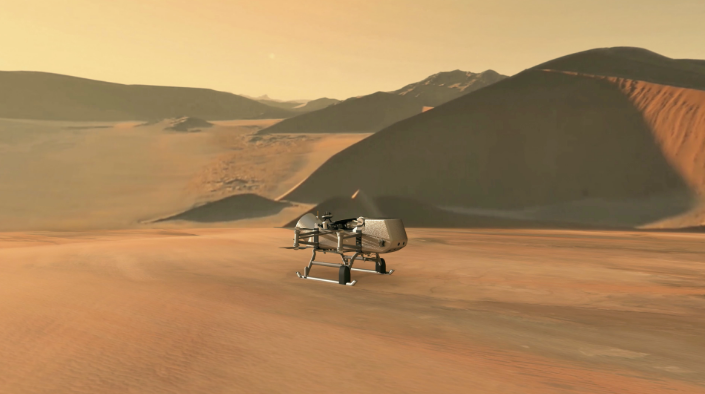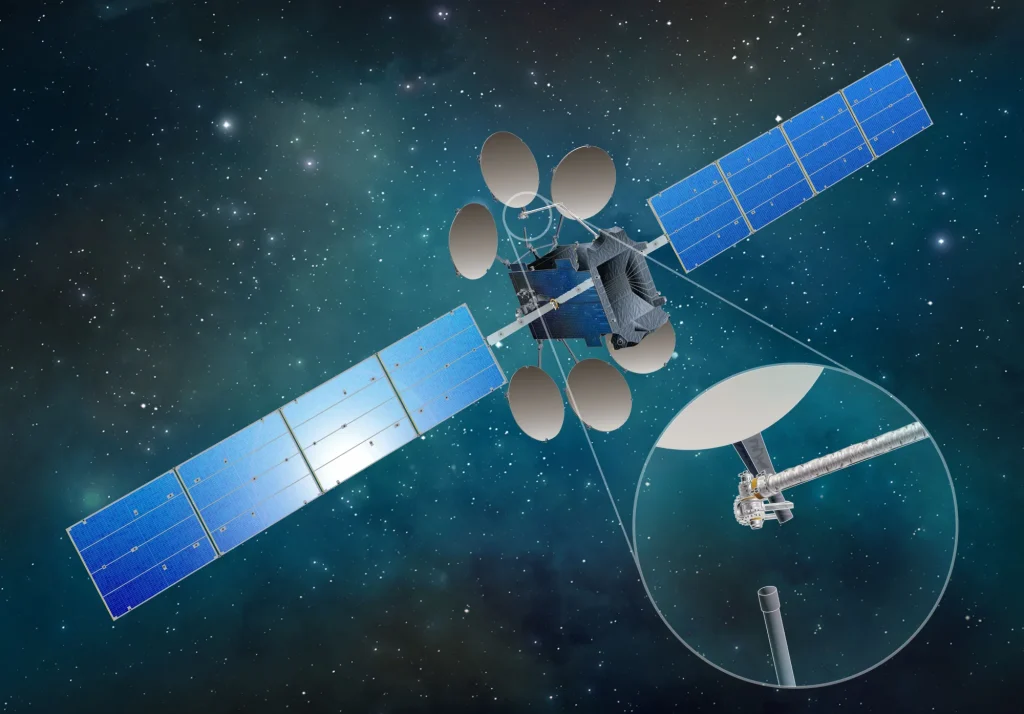NASA’s Dragonfly Mission to Saturn’s Ocean World, Titan, Got A Green Light
3rd Nov 2023
The mission that is “turning science fiction into exploration fact.” That’s how Ken Hibbard of Johns Hopkins Applied Physics Laboratory (APL) described the Dragonfly mission, which plans to launch in less than five years with the destination of Titan, a moon of Saturn.
The Applied Physics Laboratory is assisting the ambitious Dragonfly project at Johns Hopkins, and aims to gather data including potential precursors to life. It will be the first mission of its kind to another ocean world.
NASA Approved the Dragonfly Rotorcraft Mission to Saturn’s Moon Titan
Updated on 17th April
NASA has confirmed the maiden mission to Saturn’s largest moon, Titan, after receiving a budget of $3.35 billion for spacecraft development and launch. This budget is “about two times the proposed cost.”
“Dragonfly is a spectacular science mission with broad community interest, and we are excited to take the next steps on this mission,” said Nicky Fox, associate administrator of the Science Mission Directorate at NASA Headquarters in Washington. “Exploring Titan will push the boundaries of what we can do with rotorcraft outside of Earth.”
If everything goes according to plan, the mission will launch around July 2028 and arrive at Titan in 2034.
What is the Dragonfly Mission Doing?
The mission is designed to study the chemistry of this moon. The vehicle will be equipped to allow it to examine huge areas of Titan, which have already been identified as containing organic compounds that may have come into contact with the water that exists below its icy surface.
Titan is a target for research because it has water and liquid hydrocarbons that can form on the surface. This means that there is a possible primordial soup set of conditions on this moon. Understanding this environment is the main aim of NASA’s mission.
NASA’s Cassini Huygens Probe, which landed on Titan in 2005, is the furthest probe from Earth to land on a moon or planet and is one of the reasons why we know this is such a promising prospect. Images sent from the probe, which landed on the easternmost tip of a region now referred to as Adiri, provided an image of hills and so-called “rivers” that are thought to have been composed of water and ice. Everywhere water is found on Earth, life is also found.
Dragonfly instruments and tools
NASA’s documentation explains that Dragonfly “will be equipped with cameras, sensors and samplers to examine swaths of Titan known to contain organic materials.”
Among these will be:
- DraMS (Dragonfly Mass Spectrometer). A mass spectrometer to identify chemical components in samples taken on the moon,
- DraGNS (Dragonfly Gamma-Ray and Neutron Spectrometer), which will contain a deuterium-tritium Pulsed Neutron Generator and a set of gamma-ray spectrometers and neutron spectrometers to better understand the composition of the surface,
- DraGMet (Dragonfly Geophysics and Meteorology Package), which means multiple sensors including a seismometer, and
- DragonCam (Dragonfly Camera Suite). Multiple cameras that are capable of taking microscopic and panoramic images and scout the terrain of Titan.
More scientific instruments will likely be sent on the craft; these have been confirmed to be on the Dragonfly NASA mission.
The discoveries could shape the future of space travel and what we know about our own solar system. NASA Administrator Jim Bridenstine explained: “Visiting this mysterious ocean world could revolutionise what we know about life in the universe. This cutting-edge mission would have been unthinkable even just a few years ago, but we’re now ready for Dragonfly’s amazing flight.”

Credit: NASA/SSL
What is the Dragonfly Titan Rover Going to Be Like?
This Titan rover is going to be revolutionary in many different ways.
The Dragonfly craft is a rotorcraft lander that will look a little bit like a double quadcopter (an octocopter). This means that even if one of the rotors or motors is lamed during the mission, all is not lost.
The rotors will each be around 1 metre in diameter, and the craft is able to travel at about 22 mph, and up to an altitude of 4km. This will give it the ability to move around the moon and provide data from several areas.
Titan’s conditions will play a big part in the Dragonfly mission, and the low gravity and lack of wind mean that the rotors will be able to propel the craft. The rover will rely on a radioisotope thermoelectric generator to power it, which has already been proven successful on other space missions.
The Dragonfly project is planning to travel around the moon, using a lithium-ion battery, taking the heat from the natural decay of a radioisotope and turning this into energy. The craft should have a range of around 10 miles on each charge, and weigh around 990 lb.
The Dragonfly will initially land on the “Shangri-La” dune fields which are terrestrially similar to the dunes found in Namibia, Southern Africa. The further flights will be up to 5 miles long, and after each journey, the craft will gather more data, before finally reaching the Selk impact crater to explore the site where there is evidence of past liquid water and organics. In total, the lander will fly over 108 miles, which is more than double the distance of every Mars rover combined.
The sites were chosen using the Cassini-Huygens data, identifying areas and calm weather periods in which the Dragonfly can land.
“Turning science fiction into exploration fact”
On its journey, the craft will perform gravity-assist flybys of Venus and Earth to gain velocity. As it gets to the moon, the cruiser will separate from its entry capsule ten minutes before it hits the atmosphere. The lander then descends in a cleverly-designed shell and a series of parachutes.
The aeroshell is derived from the Genesis sample return capsule, and the PICA heat shield should help the spacecraft as it starts its descent. At a speed of Mach 1.5, a further parachute will deploy and slow the capsule down, protecting it for 80 minutes of its descent until the speed is low. The heat shield is then released and the landing skids extend to prepare for landing, and the lander will be released at 1.2 km altitude ready for an independent flight to the surface. As the communication between Earth and Titan has a delay of around 90 minutes, the landing will need to be autonomous.
Ken Hibbard’s October update spoke in exciting terms: “With Dragonfly, we’re turning science fiction into exploration fact,” Hibbard said. “The mission is coming together piece by piece, and we’re excited for every next step toward sending this revolutionary rotorcraft across the skies and surface of Titan.”
What Are the Challenges of the Dragonfly Mission?
The craft will face plenty of challenges including lower light levels and higher atmospheric drag on the airframe. Additionally, the dense atmosphere of Titan, which is made up largely of nitrogen, will be a challenge for the rotors to cut through.
To mitigate some of these challenges, the Dragonfly mission team has been carrying out extensive testing including at one-of-a-kind facilities created at NASA’s Langley Research Center in Hampton, Virginia.
“All of these tests feed into our Dragonfly Titan simulations and performance predictions,” Ken Hibbard explained.
Two tests took place in a 14-by-22 foot subsonic tunnel, and another two were carried out in a 16-foot Transonic Dynamics Tunnel (TDT). These tunnels are designed to validate the fluid dynamic models of APL’s scientists, as well as to simulate the gaseous atmosphere of Titan.
In June 2023, a half-scale Dragonfly model carried out hundreds of test runs according to test lead Bernadine Juliano:
“We tested conditions across the expected flight envelope at a variety of wind speeds, rotor speeds, and flight angles to assess the aerodynamic performance of the vehicle,” Juliano said. “We completed more than 700 total runs, encompassing over 4,000 individual data points. All test objectives were successfully accomplished and the data will help increase confidence in our simulation models on Earth before extrapolating to Titan conditions.”
How Much will the Dragonfly Mission Cost?
The Dragonfly mission is projected to cost in the region of $1 billion in total, though earlier in 2023 the budget was cut. NASA’s budget statement said they had “updated the budget profile to reflect updated estimates for a launch readiness date of June 2027.”
Will Dragonfly Take Pictures of Titan?
Images will be a key part of the Dragonfly mission. It is equipped with multiple cameras to take aerial images as it travels, including panoramic cameras and microscopic cameras. Some of the images taken are likely to be extremely impressive, and unlike anything we’ve seen from a space probe before.
How Long Will it Take Dragonfly to Reach Titan?
The mission to Titan will take seven years. If Dragonfly will be launched in 2028, it should arrive at its destination in 2034.
The wonderfully collaborative effort includes engineers, scientists and specialists from APL, NASA’s Goddard Space Flight Center in Greenbelt, Maryland, and many other partners including Lockheed Martin Space in Littleton, Colorado; NASA’s Ames Research Center in Silicon Valley, California; NASA’s Langley Research Center in Hampton, Virginia; Penn State University in State College, Pennsylvania; University of Central Florida in Orlando, Florida; Lockheed Martin Sikorsky in Stratford, Connecticut; Malin Space Science Systems in San Diego; Honeybee Robotics in Pasadena, California; NASA’s Jet Propulsion Laboratory in Southern California; CNES (Centre National d’Etudes Spatiales) in Paris; the German Aerospace Center (DLR) in Cologne, Germany; and JAXA (Japan Aerospace Exploration Agency) in Tokyo.






Thank you for your comment! It will be visible on the site after moderation.